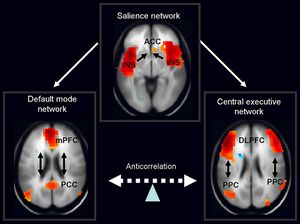Salience network
The salience network (SN) is a large scale brain network of the human brain that is primarily composed of the anterior insula (AI) and dorsal anterior cingulate cortex (dACC). It is involved in detecting and filtering salient stimuli, as well as in recruiting relevant functional networks.[1] Together with its interconnected brain networks, the SN contributes to a variety of complex functions, including communication, social behavior, and self-awareness through the integration of sensory, emotional, and cognitive information.[2]
The network is detectable through independent component analysis of resting state fMRI images, as well as seed-based functional connectivity analysis. In addition to the AI and dACC, the salience network also consists of the substantia nigra, ventral tegmental area, ventral striatum, amygdala, dorsomedial thalamus, and hypothalamus. The functional connectivity has been linked with structural connectivity through diffusion tensor imaging, which reveals white matter tracts between the AI and dACC. While the function of the salience network is not exactly known, it has been implicated in the detection and integration of emotional and sensory stimuli, as well as in modulating the switch between the internally directed cognition of the default mode network and the externally directed cognition of the central executive network.[3]
Anatomy
The salience network is primarily anchored at the AI and dACC. The node in the AI corresponds with the dorsal-anterior division distinguished in meta analyses of task-positive network related neuroimaging studies. The AI and dACC are linked via a white matter tract along the uncinate fasciculus. The subcortical nodes have yet to be structurally linked to the AI and dACC, however both seed based and resting state studies have observed intrinsic connectivity of the cortical nodes with subcortical nodes consisting of the sublenticular extended amygdala, the putamen, the dorsomedial thalamus, the ventral striatum, and the substantia nigra/ventral tegmental area.[3] The salience network is also distinguished by distinct cellular components, including spindle neurons in the AI/dACC.[3]
Cortico-striatal-thalamic loop circuits contribute to the salience network.[1]
Pathophysiology
Dysfunction in the salience network have been observed in various psychiatric disorders, including anxiety disorders, post-traumatic stress disorder, schizophrenia, frontotemporal dementia, and Alzheimer's disease. The AI node of the salience network has been observed to be hyperactive in anxiety disorders, which is thought to reflect predictions of aversive bodily states leading to worrisome thoughts and anxious behaviors. In schizophrenia, both structural and functional abnormalities have been observed, thought to reflect excessive salience being ascribed to internally generated stimuli.[4] In individuals with autism, the relative salience of social stimuli, such as face, eyes, and gaze, may be diminished, leading to poor social skills.[2]
References
- ↑ 1.0 1.1 Peters, SK; Dunlop, K; Downar, J (2016). "Cortico-Striatal-Thalamic Loop Circuits of the Salience Network: A Central Pathway in Psychiatric Disease and Treatment.". Frontiers in Systems Neuroscience 10: 104. doi:10.3389/fnsys.2016.00104. PMID 28082874.
- ↑ 2.0 2.1 Menon V. (2015) Salience Network. In: Arthur W. Toga, editor. Brain Mapping: An Encyclopedic Reference, vol. 2, pp. 597-611. Academic Press: Elsevier. https://med.stanford.edu/content/dam/sm/scsnl/documents/Menon_Salience_Network_15.pdf
- ↑ 3.0 3.1 3.2 Menon, V; Toga, A (2015). Salience Network. Elsevier. pp. 597–611. ISBN 978-0-12-397316-0.
- ↑ Menon, V (October 2011). "Large-scale brain networks and psychopathology: a unifying triple network model.". Trends in Cognitive Sciences 15 (10): 483–506. doi:10.1016/j.tics.2011.08.003. PMID 21908230.


